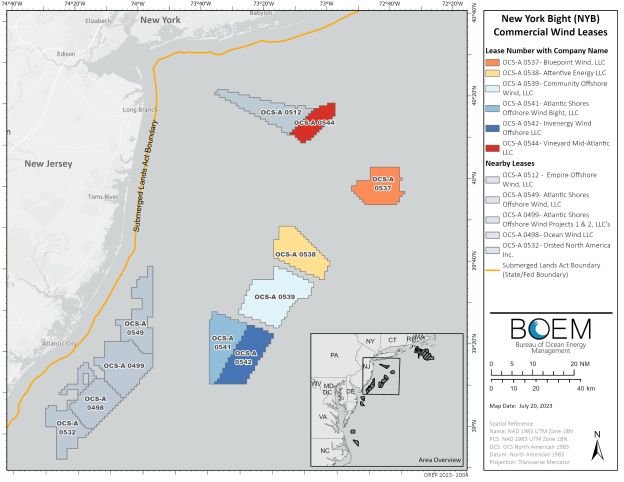The Bureau of Ocean Energy Management (BOEM) published the Notice of Availability on January 12, 2024, for the draft programmatic environmental impact statement (PEIS) on offshore wind energy development activities in the New York Bight (NY Bight)—offshore New York and New Jersey. This is the formal start of a 45-day comment period on the first BOEM regional analysis of mitigation measures for multiple offshore renewable energy lease areas.
BOEM's Decision To Develop a PEIS
BOEM announced its intention to develop a PEIS as an efficient approach to environmental review, given the close proximity of the six lease areas in the NY Bight1 and the timing at which BOEM expects to receive construction and operation plans (COPs) for review.

BOEM anticipates that the PEIS "will reduce redundancies across COP-specific NEPA analyses" and "allow for future project-specific NEPA documents to be focused on the project-specific impacts not considered in the PEIS," supporting timely decisions. BOEM will evaluate each COP submitted and determine to what extent the PEIS can be incorporated by reference into COP-specific environmental review and whether additional analysis will be warranted. The PEIS will not review any COP, nor will it approve any offshore wind development activities.
BOEM conducted a public scoping period from July 15, 2022, through August 30, 2022, to solicit input for the PEIS. BOEM received 43 comments during public scoping from a diverse range of stakeholders, including (among others) federal, state, and local agencies, industry, environmental organizations, and commercial and recreational fisheries.
Use of a Representative Project Design Envelope
As none of the NY Bight COPs had been submitted before preparation of the draft PEIS, BOEM used a representative project design envelope (RPDE) for the environmental analysis. The RPDE consists of a range of parameters that describe a hypothetical offshore wind project and is intended to be representative of any of the future projects in the NY Bight lease areas. The draft PEIS then analyzes impacts from this representative project developed in any of the NY Bight lease areas and from similar development of all six lease areas. The analysis of one single representative project allows for tiering in future COP-specific NEPA analysis,2 and the analysis of all six lease areas allows BOEM to evaluate cumulative impacts from development of the NY Bight as a whole.
To develop the RPDE and reflect a realistic project in the NY Bight, BOEM solicited input from NY Bight lessees, trade associations representing offshore wind developers, the National Renewable Energy Laboratory, New York, and New Jersey, and reviewed existing COPs. The RPDE's range of parameters represent any hypothetical project in the NY Bight, and its maximum values represent the maximum scenario of development that could occur in a lease area. The draft PEIS then uses the "maximum-case scenario," or the combination of design parameters that would result in the highest impact level for each resource analyzed, to evaluate potential impacts. When assessing impacts, BOEM considered all ongoing and planned activities in the geographic analysis area.3
Onshore component parameters (such as points of interconnection or substations) are not included in the RPDE, as they are outside BOEM jurisdiction and will not be known for the NY Bight until COPs are submitted. RPDE parameters for offshore components include the number of wind turbine generators (WTGs) in a lease area (ranging from 50 to 280 turbines), the WTG foundation type (monopiles or piled jackets, among others), the turbine height (853 to 1,312 feet), the number and type of offshore substations (OSSs) (ranging from one to five), the WTG and OSS foundation installation methods, the total interarray cable length (ranging from 33 to 555 miles), and the number of export cables (ranging from one to nine) and total export cable length (ranging from 30 to 929 miles).4
Programmatic AMMM Measures
The draft PEIS identifies programmatic avoidance, minimization, mitigation, and monitoring (AMMM) measures that BOEM proposes to require as a condition of approval of COPs in the NY Bight, unless COP-specific NEPA analysis determines that implementation of such measures is not warranted or effective.5 When BOEM issues the record of decision (ROD) for the PEIS, BOEM will commit to adopt particular AMMM measures.
Three alternatives were proposed in the draft PEIS: (1) the no-action alternative (assumes that no offshore wind development occurs in any of the six lease areas, forming the baseline for analysis of the other alternatives); (2) deferred adoption of AMMM measures (until COP-specific NEPA for the NY Bight projects); and (3) proposed action, adoption of AMMM measures (so that potential impacts of deferred adoption of AMMM measures are avoided, reduced, or mitigated).
Next Steps
Appendix G of the PEIS details the AMMM measures BOEM is considering requiring as a condition of COP approval. Several of the proposed AMMM measures have not previously been applied as a COP term or condition, and several more are not within BOEM's jurisdiction to impose. Interested stakeholders should provide feedback on the proposed AMMMs and their impact on avoiding or minimizing impacts. BOEM also requests specific feedback on the proposed and adopted approaches for compensatory mitigation. For example, BOEM has proposed that lessees "financially contribute to a third-party managed compensatory mitigation fund to address impacts on historic properties related to OCS offshore wind activities" and that lessees establish a fund to "to compensate commercial and for-hire recreational fishermen for loss of income due to unrecovered economic activity resulting from displacement from fishing grounds due to project construction and operations and to shoreside businesses for losses indirectly related to the expected development."
BOEM will hold three in-person and two virtual public meetings to solicit feedback on the draft PEIS. Public comment is due February 26, 2024.
Footnotes
1. The six commercial leases analyzed in this Draft PEIS are OCS-A 0537, 0538, 0539, 0541, 0542, and 0544, totaling over 488,000 acres (Figure 1-1), which were issued by BOEM on May 1, 2022. Based on a conservatively estimated power ratio of 3 megawatts per square kilometer, BOEM estimates that full development of leases in this area has the potential to create up to 5.6 to 7 GW of offshore wind energy.
Potential development of the leaseholds would assist with meeting several state mandates for renewable energy, including New Jersey's goal of 11 GW of offshore wind energy generation by 2040 and New York's requirement of 9.0 GW of offshore wind energy generation by 2035. Additionally, an estimated 16–18 GW of offshore wind energy may be necessary to ensure New York State achieves its Climate Act mandates.
2. Appendix C of the draft PEIS sets forth BOEM's tiering guidance.
3. Appendix D of the draft PEIS describes the ongoing and planned activities scenarios.
4. See Draft PEIS at Table ES-1. For the analysis of six NY Bight projects, BOEM anticipates development of 1,103 wind turbine generators (WTGs), 22 offshore substations (OSSs), 44 offshore export cables totaling 1,772 miles (2,852 kilometers), and 1,582 miles (2,546 kilometers) of interarray cables across the six NY Bight lease areas.
5. The resources analyzed include, among others, air quality, birds and bats, benthic, birds, commercial and for-hire recreational fishing, cultural, environmental justice, land use and coastal infrastructure, marine mammals and sea turtles, navigation, recreation and tourism), ESA-listed fish, marine minerals, national security and military use, aviation and air traffic, cables and pipelines, radar systems, and scientific research and surveys, scenic and visual, water quality. See Draft PEIS at section 3.2.
The content of this article is intended to provide a general guide to the subject matter. Specialist advice should be sought about your specific circumstances.




